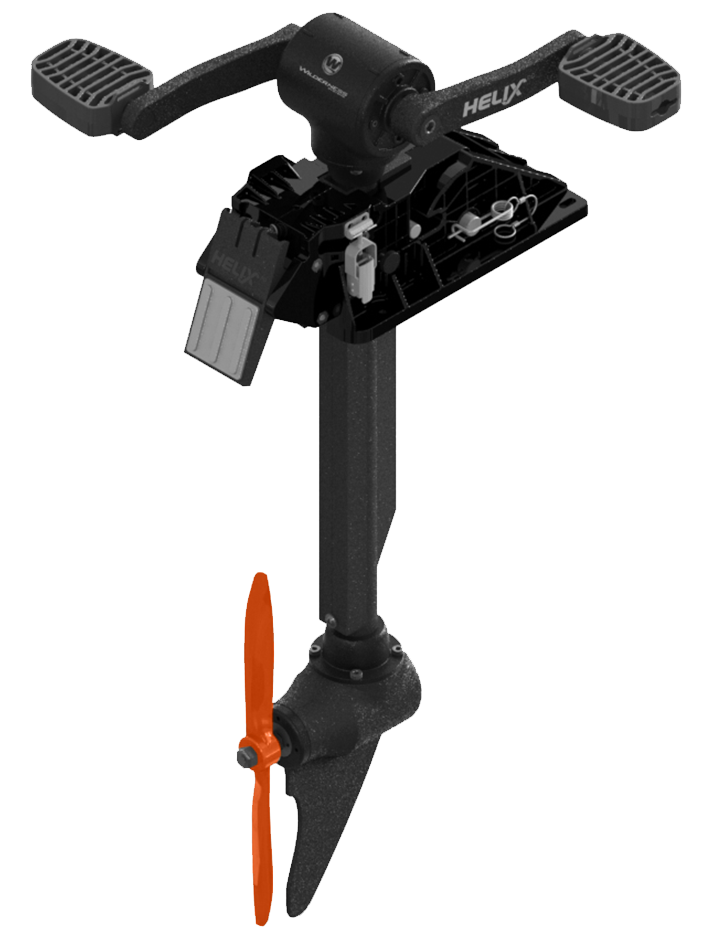
 Wilderness Systems released the RADAR 135 and 115 which work (and were designed to) with the Helix Pedal Drive. This is the first production year for the Helix PD. I’ve had both the 115 and 135 at my house and the drive arrived late last week. Delayed by storms this week, I was able to get it out for two hours and below are my findings, thoughts, and opinions.
Wilderness Systems released the RADAR 135 and 115 which work (and were designed to) with the Helix Pedal Drive. This is the first production year for the Helix PD. I’ve had both the 115 and 135 at my house and the drive arrived late last week. Delayed by storms this week, I was able to get it out for two hours and below are my findings, thoughts, and opinions.
Table of Contents
ToggleThe Good:
The Helix Pedal Drive has pretty decent speed. It prop on the drive is longer than other propeller style models and generates good speed moving through the water.
If the prop starts to tick the bottom and you need to go to paddle mode you can push the pedal to raise the drive and it will pop up to the bottom of the hull. The drive can be in a couple of different positions when you are fishing. When you want to completely raise the drive out of the water, align the prop with the opening and it will come up through the hull opening. Once the prop is completely above the opening you can pivot it forward and use the strap to lash it down if in heavy chop to avoid the stress on the pivot point, a large cylinder pin.
Having a push button drive lifter is a nice touch and definitely drier than some other options out there. I found the pedals to have a good width and grip which are important in conditions that are always wet.
It appears, though I haven’t tried, that swapping out a prop should be fairly straight forward with a couple of nuts holding it on to the drive shaft. Other drives on the market require a more invasive swap out. And I’m not completely sure that props are available to the end consumer. It is often required to have such things done at a service center/authorized retailer so it won’t void the warranty. Make sure you check into that.
Points of Improvement for the Helix Pedal Drive:
You shouldn’t have to tighten up the nuts that hold the prop. They need to have a lock nut or something to make sure it doesn’t come loose. I had to retighten the prop nut more than once while on the water. That’s a little scary if that comes off. Especially if you are a long way from the launch. The paddle back is going to suck.
As evidenced in the seven second video I posted yesterday, the Helix Pedal Drive squeaking during motion is really loud. Some Wilderness kayakers said it was the pedals making the squeak because of metal on plastic and I’ll have to try lubing the drive when I get home and verify. Maybe a metal on metal with a bearing chase could prevent that.
Another thing that could be added is a front support for the gear box. When the drive is on deck, the last contact point of the drive with the boat is about a third of the way up from the bottom of the drive. They’ve put in the large cylinder pin to help with that (I don’t like the cotter clip for what it’s worth) and it does a good job but the housing around the pin is all plastic. Going down a bumpy road with the drive still on the kayak or crashing through breakers could cause a lot of stress. Some added padding or a “head rest” near the gear box as part of the kayak would alleviate a lot of that.
I don’t like the rudder. It was specifically made for the Helix Pedal Drive kayaks. Payne Outdoors addressed it previously in the Radar paddle review and my thoughts haven’t changed. I had to readjust it on the water multiple times. Talking with some other Wildy folks about this issue and they recommend dialing it in differently. There are some videos out there on how to do this. It’s pretty finicky and lacks the turning power I’d like but again, first gen boats and pedals.
Helix PD Final Thoughts:
It is extremely important to demo this kayak and any other first generation kayak. The Helix Pedal Drive has some nice features that will get better with age but you need to see firsthand if it is a good fit for you. It’s still buggy for my taste. Especially for $1,100.
One thought on “REVIEW: Helix Pedal Drive Gen One”
Comments are closed.

I just bought a Helix PD and the same design flaws are evident. Too much movement when pedaling. So much so, that you have to move the rudder back and forth to stay on a straight path. For $1100 it should steer itself! Many weaknesses in the design. I thought, what would happen if you’re in current and go up against a hidden log or rock with the drive deployed. You’re going to swim back to shore !!
So I’m only using my drive when I’m in a lake or a large unobstructed river.